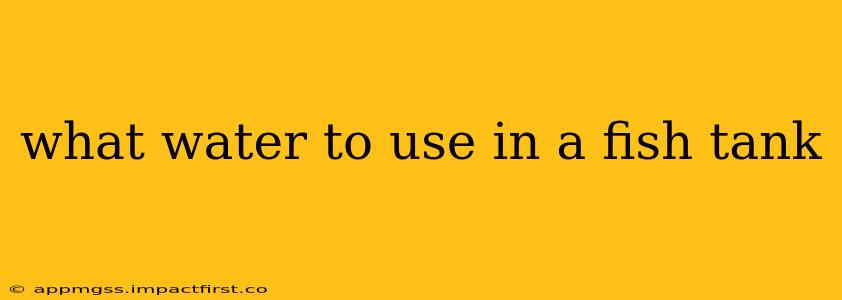Choosing the right water for your fish tank is crucial for the health and well-being of your aquatic pets. Using the wrong type of water can lead to a variety of problems, from stunted growth to serious illness and even death. This comprehensive guide will walk you through everything you need to know about selecting and preparing the perfect water for your fish tank.
What Kind of Water is Best for a Fish Tank?
The ideal water for your fish tank is dechlorinated, appropriately treated tap water or aged spring water. Let's break down why:
-
Tap Water: Most municipal water supplies are treated with chlorine and chloramine to kill harmful bacteria. These chemicals are toxic to fish. Therefore, you must dechlorinate tap water before using it in your aquarium. This can be done using a water conditioner specifically designed for aquariums, readily available at pet stores.
-
Spring Water: Bottled spring water, particularly the kind intended for drinking, is a good option provided it's been aged for at least 24 hours. This aging process allows any dissolved gases to escape, which can be harmful to fish. However, be mindful that spring water can vary significantly in its mineral content, and some minerals can be detrimental to certain fish species. Always check the mineral content before using it extensively.
-
Well Water: Well water can be used, but it requires testing to determine its mineral content and pH level. High levels of minerals like nitrates or heavy metals can be lethal. If using well water, it’s essential to test it with a water testing kit and adjust it accordingly. Often, it requires more extensive filtering.
How to Treat Tap Water for a Fish Tank
Treating tap water is a crucial step in setting up a healthy aquarium environment. Here's a step-by-step guide:
-
Allow the water to sit for 24 hours. This allows chlorine to evaporate somewhat and gives you time for the next step. However, this alone is insufficient to remove chloramine.
-
Use a water conditioner. This is the most important step. Water conditioners neutralize chlorine and chloramine, making the water safe for your fish. Always follow the instructions on the product label.
-
Check your water parameters. After treating the water, it's essential to test it using a reliable water testing kit to ensure the pH level, ammonia, nitrite, and nitrate levels are within the safe range for your fish species. Adjust accordingly using appropriate aquarium products.
What About Distilled or Reverse Osmosis (RO) Water?
While distilled or RO water are pure, they lack essential minerals vital for fish health. Using them exclusively can cause problems. These waters should ideally be remineralized using aquarium-specific mineral supplements to reach the optimal water hardness and mineral content needed by your fish.
What are the Dangers of Using Untreated Water?
Using untreated tap water, unaged spring water, or improperly treated water can result in several negative consequences for your fish:
- Death: Chlorine and chloramine are highly toxic to fish and can quickly kill them.
- Disease: Untreated water can contain harmful bacteria and parasites that can infect your fish.
- Stress: Water with incorrect parameters will cause stress to your fish, weakening their immune systems and making them more susceptible to disease.
- Stunted Growth: Inadequate water quality can hinder your fish's growth and development.
How Often Should I Change My Fish Tank Water?
The frequency of water changes depends on several factors, including the size of your tank, the number of fish, and your filtration system. As a general guideline, partial water changes (around 25-50%) should be performed weekly or bi-weekly to maintain water quality.
What Water Temperature Should I Use?
The ideal water temperature will vary depending on the species of fish you keep. Always research the specific needs of your fish to ensure you maintain the correct temperature. Using a reliable aquarium thermometer is essential for monitoring the temperature.
Can I Use Rainwater in My Fish Tank?
Rainwater can be used, but only if collected in a clean container away from pollutants. However, it’s highly recommended to test its pH and mineral levels. It may require treatment similar to tap water. Due to its variability, its use is generally discouraged.
By carefully considering these factors and following these guidelines, you can provide your fish with the clean and healthy water they need to thrive. Remember, responsible aquarium ownership includes maintaining optimal water quality.
